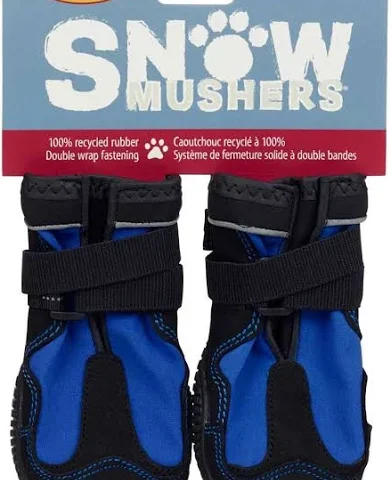By Canada Pooch on Sep 14, 2023
Do you ever wonder if your beloved dog needs winter boots? How does winter weather impact your dog’s sensitive paws? What role do dog boots play in ensuring the comfort and safety of your pet during wintertime? In this article, we delve deep into these questions and much more. From understanding the importance and benefits of winter boots for your dog to knowing how to choose the perfect pair and prepare your dog for wearing them – this guide captures everything you need to know.
Understanding the Importance of Winter Dog Boots
As temperatures fall and snow piles up, pet parents often wonder: Should my dogs wear boots? As responsible dog owners, it’s essential to understand the importance of winter dog boots to keep your furry friend safe and comfortable this winter.
A dog’s paw pads may seem tough, but they’re not immune to the harsh effects of extreme temperatures. A stroll in the cold can leave your dog’s paws vulnerable to cracking, frostbite, loaded with toxic chemicals like de-icing salts, and more. Wearing dog boots provides extra protection and can prevent potential winter-related injuries.
Just as you wouldn’t go out barefoot during a snowstorm, your dog shouldn’t either. Before venturing out in wintry weather with your dog, consider slipping on protective dog boots. Combined with the right pet gear, such as dog winter coats, a shearling dog jacket, or even a complete control harness, you can ensure your dog is ready to tackle the cold weather in its full stride!
The Dangers of Winter Weather to Your Dog’s Paws
Winter weather can be harsh on your dog’s paw pads. Walking on icy sidewalks can create small cuts and cracks on their paw pads. Moreover, rock salt and de-icers used to melt snow and ice are not only dangerous if ingested, but they can also burn and irritate your dog’s sensitive paw pads, leading to pain and discomfort when walking.
The Benefits of Winter Dog Boots
From keeping their paws safe to maintaining the cleanliness of your home, the importance of winter dog boots for pet parents extends much further than you might think. To begin with, good quality durable dog boots provide an extra protective layer over your dog’s paw pads, enabling them to brave the chill comfortably.
Protective boots even keep your dog’s paws clean from mud, wet snow, and dirt. This will likely make your life easier — less paw cleaning after walks and cleaner home floors!
The right dog boots can also offer added safety features for nighttime walks. This can include reflective stripes to help make your dog more visible in the dark. Some winter dog boots also help prevent slips and falls, allowing your dog to control slick surfaces completely.
As you consider how to keep your dog safe and comfortable this cold season, make sure also to consider their overall health and wellbeing.
In conclusion, whilst choosing dog boots might seem like a daunting task, taking time to consider your dog’s comfort and safety will definitely pay off. So, next time you bundle up to ward off the cold, don’t forget about your dog’s paw pads protection!
Choosing the Right Winter Boots for Your Dog
Your furry friend’s paw pads may seem sturdy, but they’re not invincible when braving extreme temperatures in the cold weather. The importance of winter dog boots is paramount in ensuring safety and comfort. Just like humans wear boots in winter, dogs wear boots, too, but choosing the right dog boots can be a task for pet parents.
Different Types of Dog Boots for Various Weather Conditions
Not all dog boots are created equal. There are protective dog boots for light snowfall days, dog booties designed to handle intense cold, and even dog snow shoes for those deep-snow adventures. Ensure your dog has winter coats such as a shearling dog jacket or a microfiber dog coat paired with the boots for complete warming.
The choice of boots depends on the climate, level of activity, and specific needs of your dog. For example, if you’re out dog walking in wet snow, you’ll need boots that offer a strong grip and are waterproof. An often-recommended option includes durable dog boots with reflective stripes for night walks.
How to Measure Your Dog’s Paw for the Perfect Fit
Finding the perfect fit is crucial to ensure your dog is comfortable wearing boots. First, have your dog stand on a piece of paper. Mark where the frontmost and backmost edges of his paw pads are, and measure that distance. Remember to measure all paws as they might be slightly different in size. Also, take note of the paw shape; some breeds might require specially designed boots.
Essential Features to Look for in Quality Dog Boots
Quality dog boots provide comfort, protection, and durability. One of the key features to consider is a strong grip. This prevents slipping during winter walks. Also, protective boots should provide insulation from cold climates. They should also have fastenings that stay secure, even during rough plays. You might want to consider boots that roll up or down, depending on the coverage needed.
Another feature could be compatibility with a complete control harness for dogs needing guidance or control while walking.
Considering the wide range of boots selection and varying winter conditions, it’s essential to carefully select the right snow boots, considering the paw pad care. After all, pet parents want to ensure their dog’s safety and comfort.
Ensuring Your Dog’s Comfort and Safety When Wearing Winter Boots
Dogs’ paw pads are sensitive to extreme temperatures, particularly in the winter. Wearing dog boots can help protect your pet from the cold and icy conditions. However, choosing dog boots for your pet isn’t as simple as selecting the most stylish pair. Comfort, quality, and the right fit are essential features to consider.
Winter dog boots come in various styles and materials. There’s everything from durable dog boots made of rubber or leather to dog shoes with shearling dog jackets for added warmth. You might also come across microfibre dog coats that are easy to put on and remove. When choosing boots, consider the cold weather conditions in your area. For snow, choose snow boots with a strong grip. For icy or wet conditions, waterproof boots are best.
Training Your Dog to Wear Boots Comfortably
Many pet parents may find that their dogs wear boots with a bit of reluctance at first. This is perfectly normal, as most dogs are not accustomed to wearing dog booties. Start by letting them wear boots inside the house. Reward them with dog food or treats each time they walk around with the boots without attempting to remove them. Soon enough, they should be ready for a dog-walking adventure outdoors.
Another critical factor to consider is measuring your dog’s paw correctly to ensure the boot fits correctly. An ill-fitted boot can cause more harm than good. If the shoe is too tight, it can cause discomfort or even injury. On the other hand, if the boot is too loose, it may not offer the desired protection. It’s also crucial to pay attention to features like reflective stripes, which can add visibility during evening walks.
Maintaining and Cleaning Your Dog’s Winter Boots
Like all dog accessories, from the complete control harness to the cooling vest, regular maintenance of dog boots is necessary. Clean them as per the manufacturer’s instructions, as different materials require different care. Some dog boots can be machine-washed, while others need handwashing. Regular cleaning extends the boots’ life and keeps your dog’s paw pads free from dirt and bacteria.
Avoid storing boots when they are still wet. Allow them to air dry before storage to prevent the growth of bacteria or mildew. In addition, always check the boots for any signs of wear and tear before putting them on your dog. Damaged boots may not offer adequate protection and could possibly injure your pet’s paws.
Key Safety Tips for Transitioning Your Dog to Winter Footwear
One of the biggest concerns when transitioning your dog into wearing winter footwear is their safety. If your dog seems uncomfortable or shows signs of distress when wearing the boots, it may be worth reevaluating whether the footwear is the right fit or style for them. Remember, the primary objective of wearing winter boots is to keep your dog comfortable and safe in cold climates.
When your dog first wears the boots, use a calming collection product such as a dog anxiety vest or calming sprays to help them get used to their new footwear. Also, associate the boots with positive experiences. For example, put on their snowsuit and boots just before going outside to play or take walks.
The frigid temperatures and hazardous conditions of winter can put your beloved dog’s paws at risk of injury and discomfort. As responsible pet parents, equipping our furry friends with protective winter dog boots is a practical way to safeguard their health and safety when braving the elements.
When selecting boots, carefully consider factors like waterproofing, insulation, grip, visibility reflectors, and adjustability to get the perfect fit. Invest time into properly training your dog to accept wearing them through positive reinforcement and rewards. With the proper boot style, sizing, and introduction, your dog can transition to moving naturally in their new footwear. Regularly maintain the boots by washing, drying, and checking for wear and tear.

